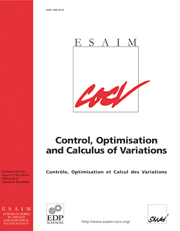Article contents
Reduction by group symmetry of second order variational problems on asemidirect product of Lie groups with positive definite Riemannian metric
Published online by Cambridge University Press: 15 October 2004
Abstract
For a Riemannian structure on asemidirect product of Lie groups, the variational problems can bereduced using the group symmetry.Choosing the Levi-Civita connection of a positive definitemetric tensor,instead of any of the canonical connections for the Lie group,simplifies the reduction of the variations but complicates theexpression for the Lie algebra valued covariant derivatives.The origin of the discrepancy is in the semidirect productstructure, which implies that the Riemannianexponential map and the Lie group exponential map do not coincide.The consequence is that the reduced equations look more complicated thanthe original ones.The main scope of this paper is to treat the reduction of second order variational problems (corresponding to geometric splines) on such semidirect products of Lie groups.Due to the semidirect structure, a number of extra terms appears in the reduction, terms that are calculated explicitely.The result is used to compute the necessary conditions of an optimal control problem for a simple mechanical control system having invariant Lagrangian equal to the kinetic energy corresponding to the metric tensor.As an example, the case of a rigid body on the Special Euclideangroup is considered in detail.
Keywords
- Type
- Research Article
- Information
- ESAIM: Control, Optimisation and Calculus of Variations , Volume 10 , Issue 4 , October 2004 , pp. 526 - 548
- Copyright
- © EDP Sciences, SMAI, 2004
References
- 17
- Cited by


